General Info
Initial Founders: John S. Pemberton
CEO: James Robert Quincey (59 yo)
Started in: 1892, Atlanta, Georgia, United States
Employees: Approx. 700,000 people globally

Financial Info
Revenue/Quarter: Approx $12.36 billion (as of Q2 FY24) (up 3% from 2Q 2023)
Net Income/Quarter: Apx $2.41 billion (Q2 FY24) (down 5.3% from 2Q 2023)
Profit margin: 21.3% (as of Q2 FY24) (down 11% from 2Q 2023)

About the Company:
Coca-Cola’s journey began in 1886, when pharmacist Dr. John Stith Pemberton created a syrup in Atlanta, Georgia. Initially marketed as a medicinal tonic, Coca-Cola was sold for just 5 cents per glass at local soda fountains. In its first year, Coca-Cola sold only about 9 drinks a day. However, the company experienced its first major leap when Asa Candler acquired the rights in 1891, pioneering one of the most significant branding and marketing strategies in history.
Coca-Cola’s rise from a modest local beverage to a global icon is a testament to its relentless focus on innovation, marketing, and distribution. Today, Coca-Cola operates in over 200 countries and sells more than 1.9 billion servings daily across its beverage portfolio. In 2022, the company’s revenue hit $43 billion, with a market capitalization exceeding $270 billion. The brand’s distinctive logo and bottle design, along with its strategic use of celebrity endorsements and memorable advertising campaigns, have cemented Coca-Cola’s place as the leading soft drink globally.
From small beginnings in Atlanta, Coca-Cola evolved into a symbol of globalization, representing not just a beverage but a cultural phenomenon that transcends borders. The journey of Coca-Cola offers numerous lessons on scaling, branding, and consumer engagement that are critical for aspiring entrepreneurs.
Founders and Early History:
Coca-Cola’s story begins in 1886 with Dr. John Stith Pemberton, an Atlanta-based pharmacist, who created a flavored syrup intended to be sold as a medicinal tonic. Pemberton developed Coca-Cola as a way to find an alternative to the opiate painkillers he had become addicted to after being wounded in the Civil War. The original formula, containing coca leaf extract and kola nuts, was marketed as a remedy for various ailments, including headaches, nervousness, and indigestion.
Initially, Coca-Cola wasn’t an immediate success. In its first year, the company only managed to sell an average of nine drinks per day, generating just $50 in sales, while the expenses amounted to over $70. It wasn’t until Asa Griggs Candler, an ambitious businessman, acquired the rights to Coca-Cola in 1891 that the brand began to flourish. Candler was responsible for shifting the focus of Coca-Cola from medicinal uses to that of a refreshing beverage. He invested heavily in advertising, spending up to $11,000 by 1895 (equivalent to nearly $350,000 today) to market Coca-Cola across the United States.

Candler’s aggressive marketing efforts resulted in a rapid expansion, with sales reaching every state by the turn of the century. Under Candler’s leadership, the company introduced one of the first-ever coupon campaigns in history, offering free samples to potential customers. By 1900, Coca-Cola was selling over 370,000 gallons of syrup annually, a stark contrast to its humble beginnings. This era laid the foundation for Coca-Cola’s global dominance.
The company’s big breakthrough came during World War II, when Coca-Cola capitalized on the conflict to gain international exposure. Coca-Cola, in partnership with the U.S. military, promised that American soldiers could buy a Coke for just 5 cents, no matter where they were stationed. This strategy led to the establishment of bottling plants near military bases across the globe. By the end of the war, Coca-Cola had built 64 bottling plants in Europe, Africa, and Asia. Not only did this initiative boost Coca-Cola’s visibility and market share, but it also helped solidify its image as a patriotic brand, further deepening consumer loyalty in the post-war era. By 1945, the company’s profits soared, with sales climbing from $95 million in 1940 to $225 million in 1945.
Branding: Building a Global Icon
Coca-Cola’s success can be attributed in large part to its masterful branding. Asa Candler laid the foundation, but the company’s continued evolution through the 20th century transformed Coca-Cola into one of the most recognizable brands in the world. One of the first major branding decisions was the iconic red logo with the distinct Spencerian script, which was introduced in the 1890s. This logo has remained consistent, helping Coca-Cola become synonymous with familiarity and trust across generations.
The introduction of the contour bottle in 1915 was a pivotal moment in Coca-Cola’s branding strategy. The bottle’s unique shape, designed to be recognizable even if shattered into pieces, became a significant part of the brand’s identity. Even today, this bottle remains an enduring symbol of the company, solidifying its association with innovation and distinctiveness.
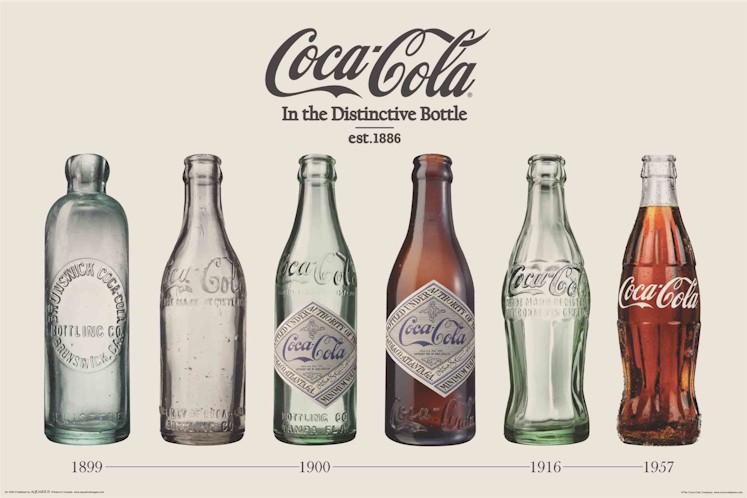
Coca-Cola’s branding strategy also extended to its advertising, making use of popular culture to reinforce its image. Some of the earliest examples of this were the “Pause that Refreshes” campaign in 1929 and the Santa Claus advertisements in the 1930s. Coca-Cola’s use of Santa Claus in marketing is credited with helping shape the modern-day image of Santa as a jolly, red-suited figure, further embedding Coca-Cola into American and global culture.
During World War II, Coca-Cola’s “war effort” branding cemented its status as a patriotic drink. Its promise to make Coke available to every American serviceman for just 5 cents worldwide not only boosted sales but also transformed Coca-Cola into a symbol of home for soldiers overseas. This was not just a strategic move in terms of visibility, but also an investment in brand loyalty. As a result, Coca-Cola was no longer just a beverage — it became a symbol of American values and freedom.
Coca-Cola’s branding extended into television during the mid-20th century, with the “It’s the Real Thing” campaign in the 1960s, and later the famous “I’d Like to Buy the World a Coke” ad in 1971. These campaigns pushed Coca-Cola’s message beyond just a product — it was now a lifestyle and a global connector of people. The “I’d Like to Buy the World a Coke” ad became one of the most influential advertisements of all time, contributing to Coca-Cola’s status as a global icon.
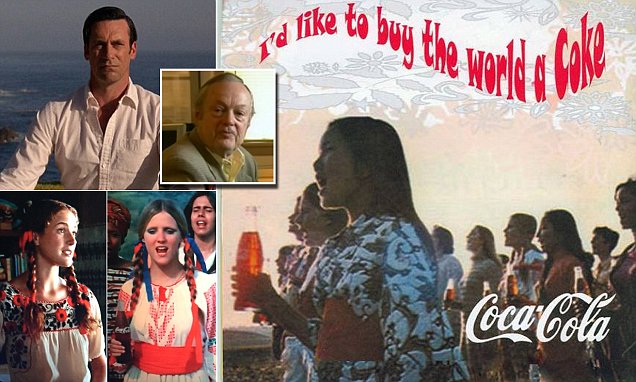
By 2022, Coca-Cola was ranked as the third most valuable brand globally, with a brand value of over $97 billion, according to Interbrand. It operates in over 200 countries and continues to lead the global non-alcoholic beverage market. Coca-Cola’s ability to adapt its brand to new markets while maintaining its core identity has been key to its longevity and dominance in the industry.
Product Innovation and Evolution
Coca-Cola’s success story is heavily tied to its ability to continually innovate while staying true to its core product. From its inception in 1886 as a medicinal tonic to becoming a global icon, Coca-Cola has consistently introduced new products and adapted to consumer preferences.
Core Product Expansion
While the original Coca-Cola formula remains its most iconic product, the company has significantly expanded its product portfolio. In 1960, the acquisition of Minute Maid marked Coca-Cola’s entrance into the juice market. By 1982, Coca-Cola ventured into the diet beverage market with the launch of Diet Coke, a decision driven by increasing consumer health consciousness. This innovation was wildly successful, with Diet Coke becoming the second-best-selling soft drink in the U.S. behind Coca-Cola by 2010, surpassing Pepsi.

In 2005, Coca-Cola Zero Sugar (originally Coca-Cola Zero) was introduced, targeting consumers who wanted the taste of Coca-Cola without the sugar or calories of regular Coke. In fact, by 2019, Coca-Cola Zero Sugar posted an impressive 14% growth in sales.
Diversification Strategy
Coca-Cola has been proactive in diversifying beyond carbonated drinks to appeal to a broader audience. Its acquisition strategy has been a key driver in this area. For instance, the company acquired Vitaminwater in 2007 for $4.1 billion and has since expanded its portfolio to include Powerade (sports drinks), Dasani (bottled water), Honest Tea, and Costa Coffee. The $5.1 billion acquisition of Costa Coffee in 2018 allowed Coca-Cola to break into the global coffee market, positioning it as a competitor in the rapidly growing ready-to-drink coffee segment.
This strategy of innovation and diversification has paid off. By 2021, approximately 40% of Coca-Cola’s sales were from non-carbonated beverages, demonstrating how the company evolved beyond its original product.
Sustainable Packaging
In recent years, Coca-Cola has also focused on sustainability through its packaging. In 2021, Coca-Cola introduced bottles made from 100% recycled plastic in the U.S. as part of its goal to make all packaging recyclable by 2025 and reduce its carbon footprint by 25% by 2030. The company also aims to collect and recycle the equivalent of every bottle or can it sells by 2030. These sustainability efforts have contributed to Coca-Cola’s innovation strategy and bolstered its reputation among eco-conscious consumers.
Overall, Coca-Cola’s ability to innovate its product line, diversify into other beverage segments, and maintain a strong focus on sustainability has allowed it to stay relevant in an ever-changing marketplace. With a product portfolio of over 500 brands and billions of servings consumed daily across the globe, Coca-Cola continues to lead the beverage industry.
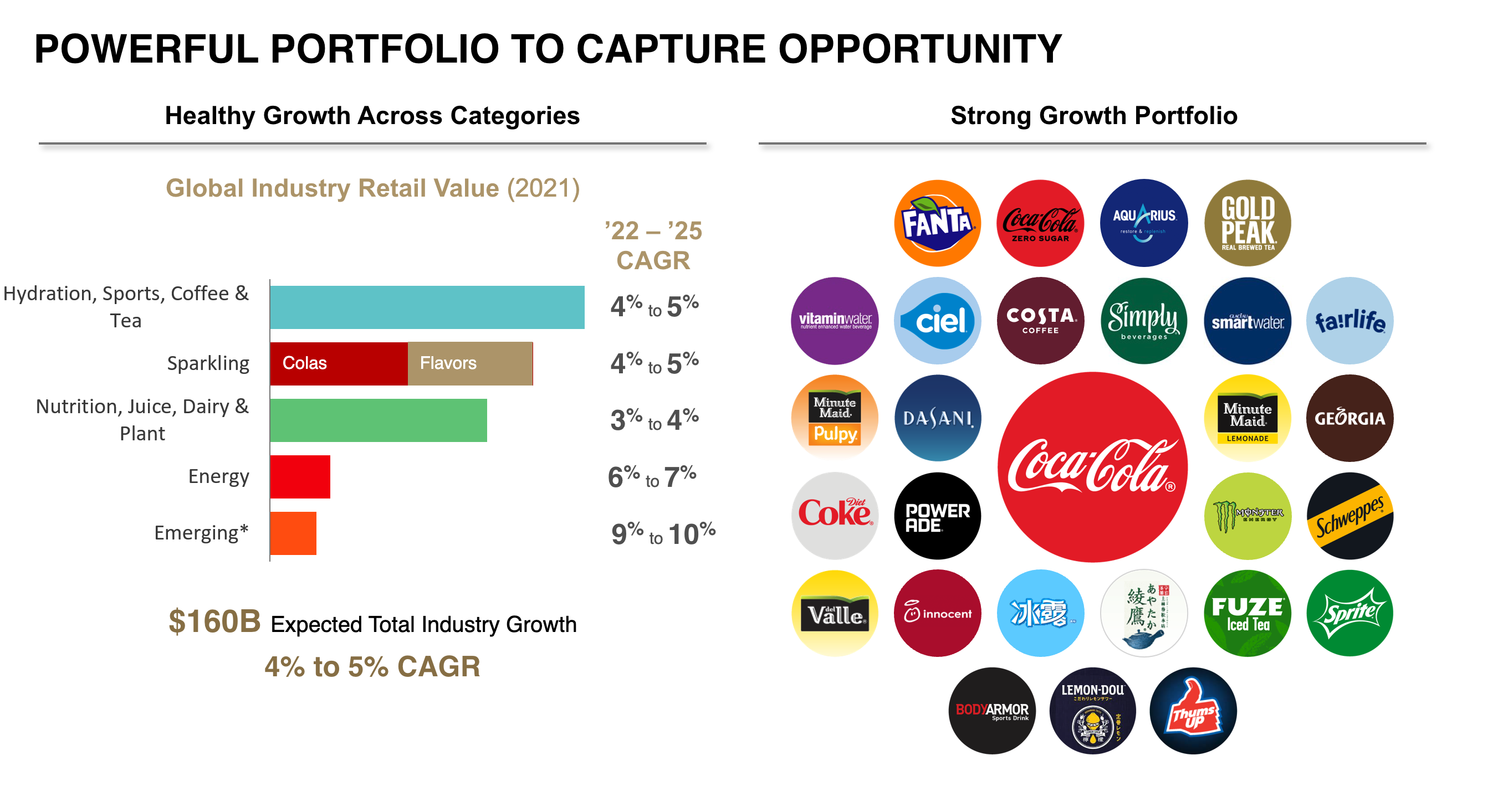
Franchising and Distribution Strategy
Coca-Cola’s innovative franchising and distribution strategy has been one of the most important factors behind its global dominance. The company operates under a franchise bottling model, which means Coca-Cola sells its syrup concentrate to independently owned bottling partners, who are responsible for producing, packaging, and distributing the final product. This allows Coca-Cola to maintain control over its product quality while benefiting from a local presence in markets around the world.
Franchising Model Growth: The franchising model was pioneered by Coca-Cola in the late 19th century, with its first bottling agreement established in 1899. The Coca-Cola Company realized that this model allowed for rapid scaling, without the need to directly handle the heavy capital investment required for bottling and distribution. By 1920, Coca-Cola had over 1,000 bottling plants across the U.S., and it wasn’t long before this strategy was applied internationally.
The flexibility of this franchising system has been critical to Coca-Cola’s expansion into markets with vastly different economic, regulatory, and cultural landscapes. For example, by the 1950s, Coca-Cola was operating in over 120 countries, and today, the company’s products are sold in more than 200 countries. Coca-Cola’s decentralized model allows bottling partners to adapt production and marketing strategies to local tastes while still maintaining the core brand image.
Distribution Network: Coca-Cola’s distribution network is vast and complex. The company operates the largest beverage distribution system in the world, serving more than 1.9 billion servings every day. Coca-Cola has over 225 bottling partners globally, each of which is responsible for ensuring the availability of Coca-Cola products in local markets. These bottling partners collectively operate more than 900 plants and distribute products to 27 million customer outlets around the world.
In terms of logistics, Coca-Cola relies on an efficient supply chain to ensure that its products reach consumers as fresh as possible. The company uses a combination of warehousing, direct store delivery (DSD), and third-party distribution services to keep costs low while maintaining extensive market coverage. This allows Coca-Cola to serve both large retailers and small neighborhood shops, contributing to its widespread availability.
Revenue Share: Coca-Cola generates its revenue primarily from selling concentrate to bottling partners, who then handle the manufacturing and distribution process. This model allows Coca-Cola to focus on branding, marketing, and product innovation while outsourcing the capital-heavy bottling operations. In 2022, Coca-Cola reported $43 billion in net operating revenues, a significant portion of which came from its bottling and distribution agreements. In terms of market share, Coca-Cola consistently commands over 40% of the global carbonated soft drinks market, with the company’s revenue growth showing resilience even during economic downturns.
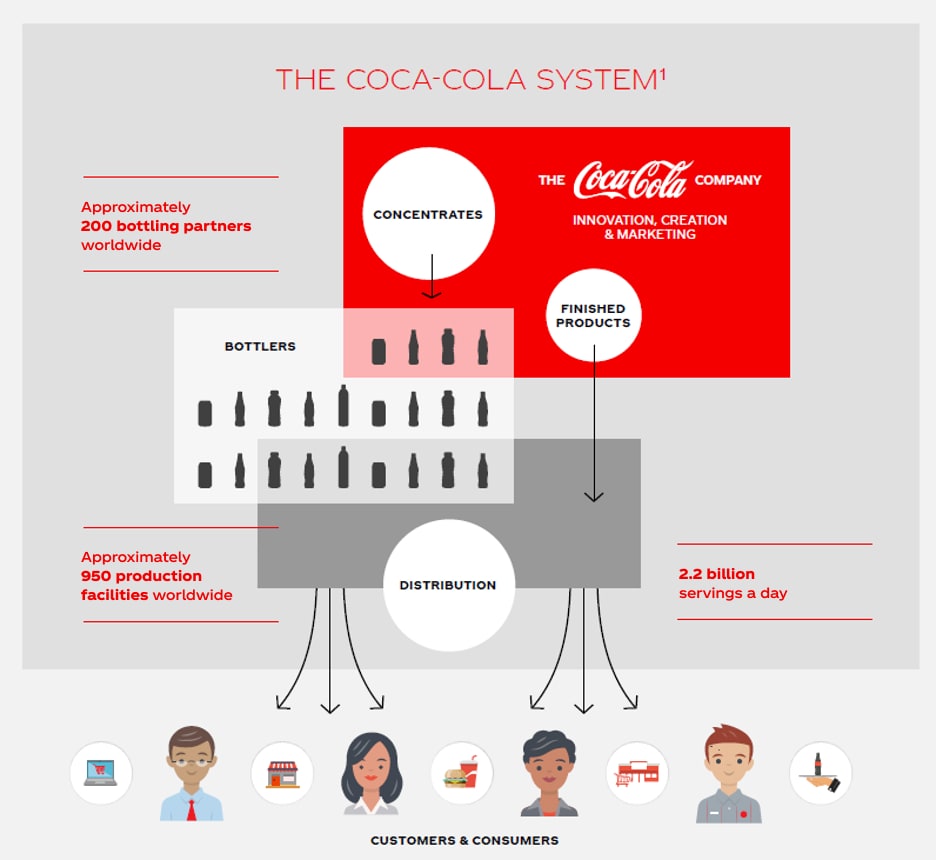
Franchise Bottling Strategy: A key evolution in Coca-Cola’s franchise model came in 2017 when it began implementing the refranchising strategy. This approach involved divesting company-owned bottling operations to independent bottlers. For example, in North America, Coca-Cola sold its bottling operations to third-party bottlers, a move that allowed Coca-Cola to significantly reduce its capital expenditures. This refranchising initiative has been credited with helping Coca-Cola streamline operations, improve profitability, and refocus its efforts on marketing and innovation. By 2020, over 90% of Coca-Cola’s bottling operations were managed by its partners.
Marketing and Advertising Strategies
Coca-Cola’s marketing and advertising have been pivotal to building its brand identity as a global cultural symbol. The company’s strategies have evolved over the decades, ensuring the brand remains relevant and connected to consumers across the world. Here’s a breakdown of key strategies:
1. Emotional Branding and Storytelling:
- “Open Happiness” Campaign (2009): This campaign focused on associating Coca-Cola with moments of joy and happiness. By tapping into universal emotions, Coca-Cola reinforced its positioning as a brand that’s not just a beverage but a part of life’s most treasured moments.
- “Taste the Feeling” (2016): This campaign unified all Coca-Cola products under a single tagline, focusing on the personal and shared experiences associated with drinking Coca-Cola. The campaign was implemented across 200 countries, reflecting Coca-Cola’s desire to bring global consistency with local relevance.
2. Celebrity Endorsements:
- Over the years, Coca-Cola has partnered with global celebrities to enhance brand appeal. For example, artists like Elvis Presley and Whitney Houston have been featured in their campaigns, enhancing their global reach.
- In India, Coca-Cola partnered with Bollywood star Shah Rukh Khan, leveraging his massive fan base for regional market penetration.
3. Creative Slogans and Memorable Ads:
- Coca-Cola has consistently rolled out iconic ad campaigns that resonate with consumers. The “Share a Coke” campaign (2011) personalized bottles with consumer names, becoming a viral hit across 80 countries, boosting sales by 2% in the U.S. alone in the first year of launch.
- The company’s holiday ads with Santa Claus have been one of the most recognized marketing campaigns globally, starting in 1931, embedding Coca-Cola into holiday traditions.
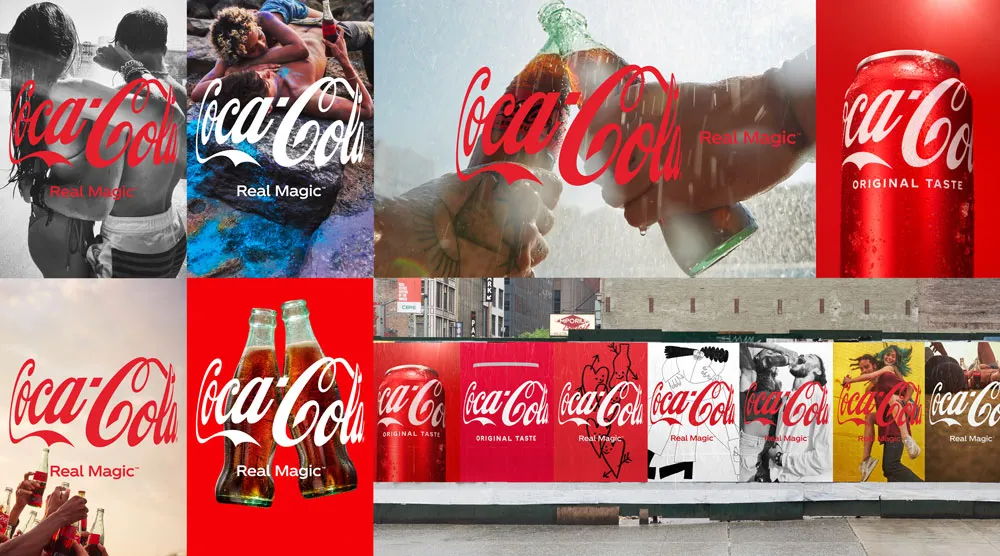
4. Consistent Global Advertising Spend:
- Coca-Cola’s advertising budget has been one of the highest in the beverage industry. In 2021, Coca-Cola spent $4 billion on advertising, a substantial commitment to maintaining its dominant market position.
- The company focuses heavily on digital channels, including partnerships with Facebook, Instagram, and YouTube, to target younger consumers.
5. Sponsorships and Event Marketing:
- Coca-Cola has sponsored the Olympic Games since 1928, which has given it unmatched global visibility. In 2012 alone, Coca-Cola’s Olympic campaign generated over 1 million social media mentions.
- The FIFA World Cup sponsorship is another long-term strategy, associating Coca-Cola with global sports events and tapping into football’s massive fanbase. In the 2018 World Cup, Coca-Cola’s “Ready for” campaign reached more than 3.6 billion people worldwide.
6. Localized Marketing:
- Coca-Cola customizes its marketing campaigns to resonate with local cultures and tastes. For example, in China, the brand launched ads that promoted Coca-Cola as a drink for all meal occasions, leading to significant consumption growth during family gatherings.
Customer Loyalty and Engagement
Coca-Cola’s ability to build and maintain a loyal customer base has been central to its enduring success. The brand’s strategies to foster loyalty extend beyond the product to create long-term emotional bonds with its customers.
1. Loyalty Programs:
- Coca-Cola’s “My Coke Rewards” program (launched in 2006) allowed consumers to collect codes from products and redeem them for a variety of rewards, including discounts, merchandise, and exclusive experiences. The program saw tremendous engagement, with 22 million users by 2015 before being revamped into more localized versions.
- In 2020, Coca-Cola launched a new loyalty app in some markets, allowing users to scan their purchases and earn rewards such as free products or charity donations, reinforcing engagement in digital-first markets.
2. Engaging with the Digital Generation:
- Coca-Cola’s digital engagement strategies have centered on tapping into social media platforms. With over 107 million followers on Facebook, 3 million on Instagram, and highly interactive YouTube content, Coca-Cola consistently leverages social media for two-way conversations with consumers.
- The brand frequently uses hashtags like #ShareACoke and interactive platforms to encourage user-generated content, creating a participatory customer culture.
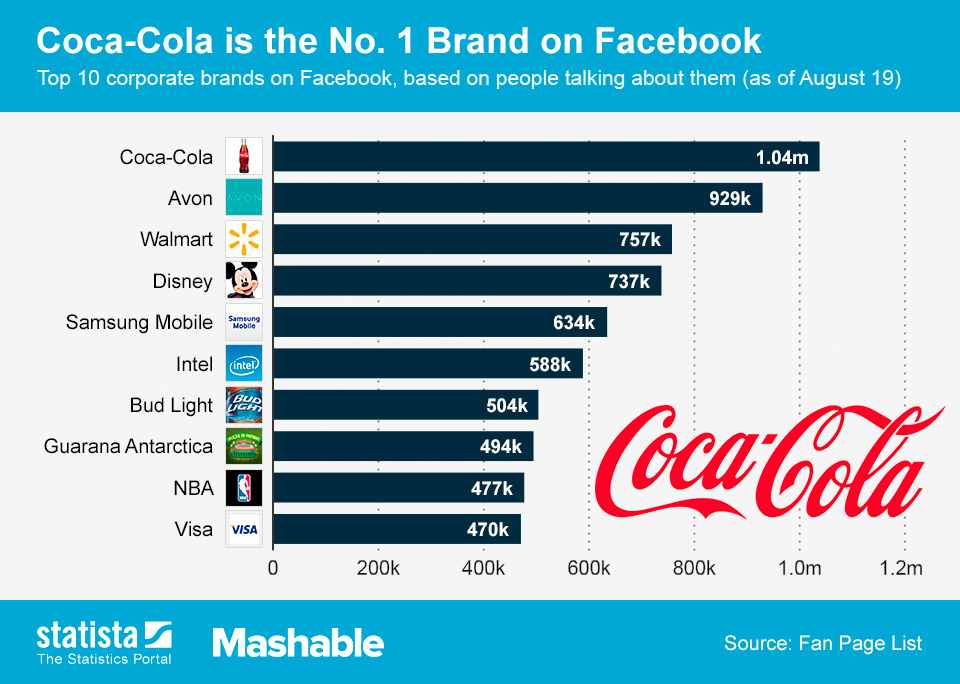
3. Personalization and Customer Interaction:
- The “Share a Coke” campaign was one of the brand’s most successful personalized marketing efforts. By printing names on bottles, Coca-Cola personalized the customer experience, generating a sense of connection and boosting sales in 80 countries.
- Coca-Cola has also experimented with virtual assistants and AI-driven technologies to engage with customers, offering personalized experiences through Coca-Cola vending machines and retail promotions.
4. CSR and Community Engagement:
- Coca-Cola builds strong emotional connections through its corporate social responsibility (CSR) initiatives. The company’s “5by20” program, launched in 2010, aimed to empower 5 million women entrepreneurs in developing countries by 2020. As of 2019, over 3 million women had been supported through training programs and micro-financing.

- Coca-Cola’s global partnerships with charities and environmental initiatives (such as reducing plastic waste and replenishing water) have enhanced customer loyalty, particularly among environmentally conscious consumers. By 2021, Coca-Cola had replenished more than 100% of the water it used in its products globally.
5. Customer Data and Feedback Loops:
- Coca-Cola uses data analytics to gather insights into customer preferences and adjust its offerings accordingly. The company’s smart vending machines, which can track customer purchase behavior, allow Coca-Cola to provide targeted promotions and offers.
- Through social listening tools, Coca-Cola also tracks online conversations to identify trends and respond to customer concerns or suggestions, which helps build a closer relationship with its audience.
6. Experiential Marketing:
- Coca-Cola’s “Happiness Machines” and other experiential campaigns have fostered direct interaction with consumers, creating unforgettable brand experiences. These vending machines would dispense not just Coke, but surprises like flowers or even pizzas, promoting customer delight and engagement.
- Coca-Cola also engages customers through its various brand stores globally, which provide immersive experiences, exclusive products, and tours that create lasting memories and deepen loyalty.
7. Customer Retention via Packaging and Price Strategy:
- Coca-Cola is adept at using packaging innovations to retain customer interest. From unique bottle shapes to collectible cans during special occasions like the FIFA World Cup, Coca-Cola continually refreshes its product presentation.
- The company also adopts localized pricing strategies to remain affordable and accessible in developing markets, driving repeat purchases.
Global Expansion and Market Penetration
Coca-Cola’s global expansion has been one of the most successful and far-reaching in corporate history, turning the brand into an international icon. The company’s strategies focused on entering new markets, adapting to local tastes, and using innovative distribution networks.]
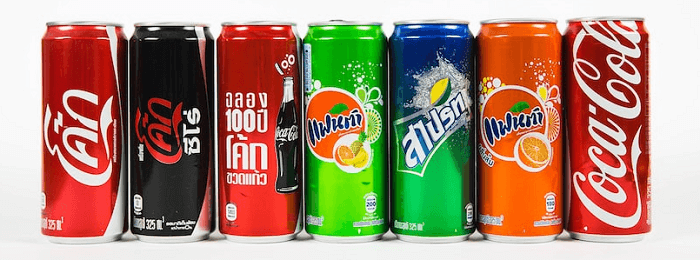
1. Entry into International Markets:
- Coca-Cola’s global journey began in the early 20th century, with the first bottling plants established in Canada and Cuba by 1906. By the end of World War II, Coca-Cola had penetrated over 44 countries. Today, Coca-Cola operates in more than 200 countries worldwide.
- A significant growth moment came in the post-World War II era when Coca-Cola capitalized on the presence of American soldiers overseas. The company set up bottling plants wherever U.S. military bases were located, ensuring soldiers had access to Coca-Cola, which helped boost brand recognition globally. By the end of the war, the brand was established in markets as far-reaching as Europe and Asia.
2. Localized Bottling Partnerships:
- Coca-Cola uses a franchise-based model for bottling operations, which has been central to its global expansion. Local bottling partners invest in production and distribution while adhering to Coca-Cola’s strict quality and brand standards. This allowed the company to grow quickly without having to bear the full cost of infrastructure in new markets.
- Today, Coca-Cola’s global system includes more than 225 bottling partners, responsible for delivering Coca-Cola products in localized regions. This decentralized model allows the company to meet local preferences while maintaining a unified global brand presence.
3. Adapting to Local Markets:
- Coca-Cola’s success in global markets is due to its ability to adapt its products and marketing to meet the tastes and cultural nuances of local consumers. For instance, in Japan, Coca-Cola introduced more than 100 different product variations, including canned coffee and teas, to cater to local preferences. Similarly, in India, Coca-Cola offers smaller bottles at affordable price points to tap into the rural market, where affordability is key.
- Coca-Cola also tailors its marketing strategies to align with local events, holidays, and cultural moments. For example, during the Chinese New Year, Coca-Cola uses traditional symbols and packaging to appeal to the cultural sentiments of Chinese consumers.
4. Market Penetration and Distribution Network:
- Coca-Cola’s distribution network is one of the most extensive in the world. It reaches even the most remote areas, ensuring its products are available to consumers across various geographies. The company’s “last-mile” delivery systems ensure products are available in small neighborhood stores and rural areas.
- In terms of market penetration, Coca-Cola has become a leader in many of the markets it operates in. For example, as of 2021, Coca-Cola held 43.7% of the U.S. carbonated soft drink market, far ahead of its competitors like Pepsi, which held 24.1%.
- Coca-Cola also made significant inroads into emerging markets such as China, India, and Brazil. In China, Coca-Cola has captured almost 65% of the carbonated soft drink market, with similar success in Latin American countries like Mexico.
5. Statistics on Global Reach:
- Coca-Cola products are consumed at a rate of more than 1.9 billion servings per day globally.
- In 2022, Coca-Cola’s global revenues reached $43 billion, with approximately 70% of its revenue generated outside the United States.
- Coca-Cola has more than 500 brands under its portfolio, with over 3,500 products available globally, showcasing its vast international product diversity.

Challenges Faced: Competition and Criticism
Despite Coca-Cola’s immense success, the company has faced numerous challenges, from intense competition to criticism over its health impacts and environmental footprint.
1. Intense Competition:

- Coca-Cola’s primary competitor in the global beverage market has been PepsiCo. The “Cola Wars” between the two companies have been ongoing since the 1970s, particularly in the U.S. market. Pepsi frequently launches aggressive marketing campaigns targeting Coca-Cola, such as the famous Pepsi Taste Challenge, which led to increased market share for Pepsi in the 1980s.
- In the U.S. market, Coca-Cola and Pepsi together control approximately 70% of the carbonated soft drink market, with Coca-Cola holding a slight edge. However, competition has also emerged from non-carbonated beverage brands. Companies like Nestlé and Red Bull have captured significant market share in bottled water, energy drinks, and juices, pushing Coca-Cola to expand its product portfolio to stay competitive.
- In recent years, Coca-Cola has faced competition from local brands in various regions. For instance, in India, Parle Agro has been a fierce competitor with its Frooti mango drink, compelling Coca-Cola to introduce region-specific fruit beverages.
2. Health Criticism and Soda Taxes:
- One of Coca-Cola’s most persistent challenges has been criticism over the health effects of its sugary beverages, which are linked to obesity, diabetes, and other health issues. As consumers have become more health-conscious, Coca-Cola’s sales of carbonated soft drinks in the U.S. have steadily declined.
- Many countries have introduced sugar taxes to curb the consumption of sugary drinks. In the U.K., Coca-Cola faced the Soft Drinks Industry Levy in 2018, which taxed beverages based on sugar content. The tax led to Coca-Cola reformulating its recipes and introducing smaller portion sizes to avoid penalties.
- In response to health concerns, Coca-Cola has expanded its portfolio to include more health-conscious options such as Coca-Cola Zero Sugar, Diet Coke, and Dasani Water. These brands now contribute significantly to the company’s sales mix, with Coca-Cola Zero Sugar showing a 4% growth in 2021.
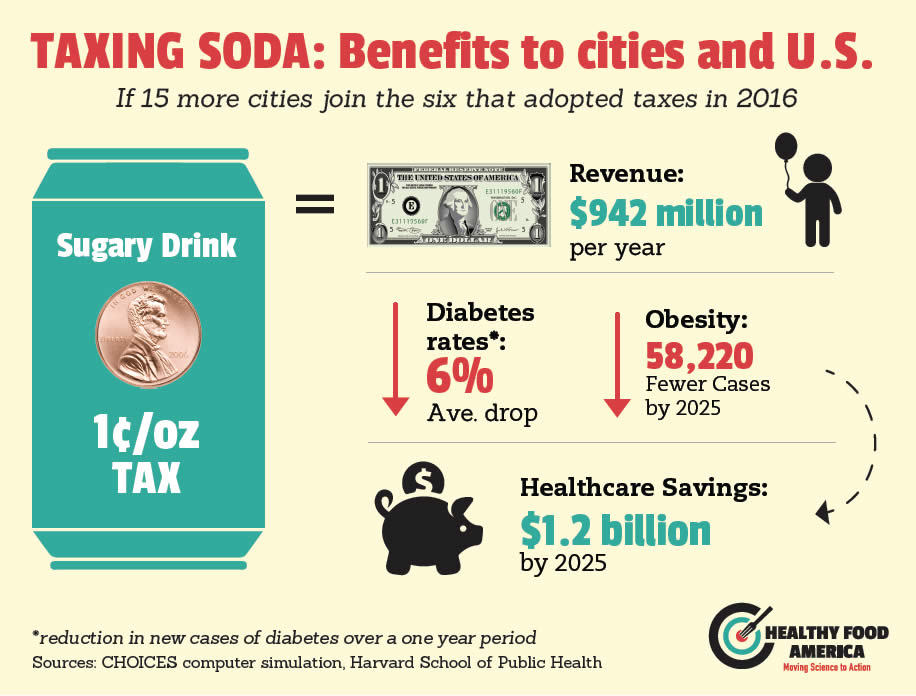
3. Environmental Criticism:
- Coca-Cola has been criticized for its environmental impact, particularly its contribution to plastic waste. The company has consistently been named as one of the world’s largest plastic polluters. In 2020, Coca-Cola was ranked as the world’s largest plastic polluter by Break Free from Plastic.
- In response to mounting criticism, Coca-Cola has committed to sustainability initiatives such as World Without Waste, launched in 2018. The goal is to collect and recycle one bottle or can for every one sold by 2030. Coca-Cola has also pledged to make all its packaging 100% recyclable by 2025.
- Despite these initiatives, Coca-Cola has faced criticism for not doing enough to reduce plastic use. Some environmental groups argue that Coca-Cola should prioritize reducing single-use plastics rather than focusing solely on recycling.
4. Crisis During the COVID-19 Pandemic:
- The COVID-19 pandemic disrupted Coca-Cola’s operations, particularly in its food service and on-premise sales, which accounted for a significant portion of its revenue. During 2020, Coca-Cola’s global revenue declined by 11%, primarily due to the closure of restaurants, cinemas, and other venues that typically serve Coca-Cola products.
- Despite this setback, Coca-Cola managed to rebound in 2021 by focusing on its off-premise channels such as grocery stores and direct-to-consumer sales. By the end of 2021, Coca-Cola’s revenue increased by 17%, reaching $38.7 billion as the world began to recover from the pandemic.
5. Water Usage and Corporate Social Responsibility:
- Coca-Cola has faced criticism over its water usage, particularly in regions facing water scarcity. In India, Coca-Cola was accused of depleting groundwater levels in some areas, leading to protests and plant closures.
- To address these issues, Coca-Cola launched initiatives aimed at improving water sustainability, including its pledge to replenish 100% of the water it uses by 2020. By 2021, Coca-Cola had met and exceeded this target, replenishing 1.75 trillion liters of water.
Adaptation to Consumer Trends
Coca-Cola’s ability to adapt to shifting consumer preferences has been a key factor in its continued success over more than a century. The company has remained resilient in the face of changing attitudes toward health, sustainability, and personalization by innovating its product offerings, modifying its marketing strategies, and evolving its business practices.
1. Shift to Health-Conscious Beverages:
- As consumers became more health-conscious, particularly in Western markets, Coca-Cola experienced declining sales in its traditional carbonated soft drinks (CSD) segment. Between 2000 and 2019, CSD consumption in the U.S. dropped by 25%, largely driven by concerns over sugar content and its links to obesity and diabetes.
- In response, Coca-Cola has diversified its portfolio to include low-calorie, zero-sugar, and healthier options. Coca-Cola introduced Coca-Cola Zero Sugar in 2005, which saw 4% growth in global sales in 2021. The company also launched Diet Coke, flavored variants of Coca-Cola Zero, and products like Coca-Cola Life with natural sweeteners like stevia.
- By 2021, 43% of Coca-Cola’s beverage portfolio was made up of low or no-sugar options, reflecting the company’s commitment to meeting the demand for healthier beverages.
2. Entry into the Non-Carbonated Beverage Market:
- To cater to consumers seeking alternatives to sugary sodas, Coca-Cola expanded into non-carbonated beverages. It now offers bottled water, teas, juices, sports drinks, plant-based beverages, and even coffee.
- Notable acquisitions include Glacéau, the maker of Vitaminwater, for $4.1 billion in 2007, and Costa Coffee in 2019 for $5.1 billion. Costa Coffee provided Coca-Cola with a significant entry into the global coffee market, a category that has grown rapidly in recent years.
- The company’s Dasani and Smartwater bottled water brands, along with the acquisition of Honest Tea and Simply Orange, positioned Coca-Cola as a serious player in the healthier beverages market. In 2021, non-carbonated beverages made up 25% of Coca-Cola’s total sales, up from just 10% a decade earlier.
3. Customization and Personalization:
- With the rise of consumer demand for personalized products, Coca-Cola launched initiatives to cater to individual tastes. The introduction of Coca-Cola Freestyle machines, which allow consumers to mix and match their own flavors, was a breakthrough in customization. These machines, which have over 100 flavor options, are now available in over 50,000 locations worldwide.
- Coca-Cola also launched its “Share a Coke” campaign, where cans and bottles were personalized with popular names. This campaign, launched in 2011, became a global success, contributing to an increase in sales across multiple markets by 2% in the U.S. and even higher in international markets.
4. Sustainability and Eco-Friendly Packaging:
- As consumers became more environmentally conscious, Coca-Cola responded by increasing its focus on sustainability. The World Without Waste initiative, launched in 2018, aims to collect and recycle the equivalent of every bottle or can it sells by 2030. As of 2022, Coca-Cola had achieved a 60% collection rate on a global scale.
- Coca-Cola has also pledged to make its packaging 100% recyclable by 2025 and to use 50% recycled materials in its packaging by 2030. In 2021, the company introduced its first bottle made from 100% recycled PET plastic in select markets.
- Additionally, Coca-Cola has invested in reusable packaging. It aims to sell 25% of its beverages in reusable containers by 2030, as part of its effort to reduce single-use plastics.
5. E-Commerce and Digital Transformation:
- Coca-Cola has embraced digital transformation and e-commerce to adapt to the increasing shift towards online shopping, particularly accelerated by the COVID-19 pandemic. The company saw a 50% increase in its e-commerce sales in 2020 as consumers turned to online platforms to purchase beverages.
- Coca-Cola launched its Direct-to-Consumer (D2C) e-commerce site, Coca-Cola Store, allowing customers to order personalized products and gift items. The company also expanded its partnerships with major retailers, food delivery apps, and third-party platforms like Amazon to boost its digital presence.
- The company also utilized AI-driven marketing to target customers with personalized content and advertisements, increasing engagement and conversion rates. Coca-Cola’s investment in digital marketing and e-commerce platforms resulted in 4% growth in direct-to-consumer sales in 2021, a segment that the company expects to grow even more in the coming years.

6. Statistics Reflecting Adaptation Success:
- Coca-Cola’s revenue from low- and no-calorie beverages saw a 35% increase between 2015 and 2021, reflecting its successful adaptation to health trends.
- In the global bottled water market, Coca-Cola holds a 13% market share, competing with brands like Nestlé and PepsiCo.
- As of 2021, Coca-Cola’s Freestyle machines were dispensing over 14 million drinks daily, highlighting the success of its customization strategy.
7. Localized Offerings and Cultural Sensitivity:
- Coca-Cola has adapted to local consumer trends in various regions by offering unique products that cater to specific tastes. For example, in Japan, Coca-Cola introduced Coca-Cola Plus, a version of the beverage enhanced with fiber, and Ayataka green tea. In India, Coca-Cola offers Thums Up, a cola product specifically formulated for Indian taste preferences, which holds a 42% market share in the carbonated beverage segment.
- Additionally, Coca-Cola’s seasonal and culturally specific packaging designs during holidays like Chinese New Year and Diwali have resonated strongly with local consumers, driving higher engagement and sales in those regions.
Lessons for Entrepreneurs: Key Takeaways from Coca-Cola’s Success
Coca-Cola’s journey from a small soda company to a global beverage giant offers numerous lessons for entrepreneurs seeking long-term success. These lessons reflect not just the brand’s ability to scale but also its adaptability, strategic marketing, and commitment to innovation. Here are the most impactful takeaways for aspiring entrepreneurs:
1. Build a Strong Brand Identity
- Coca-Cola’s brand identity is synonymous with happiness, refreshment, and global unity. Since the early days, Coca-Cola has emphasized consistent messaging and visual branding, from its iconic red and white logo to memorable taglines like “Open Happiness” and “Taste the Feeling.”
- Lesson: Entrepreneurs should prioritize building a brand that resonates emotionally with their target audience. A strong, memorable brand can create lasting customer loyalty and distinguish you from competitors.
- Stat: As of 2023, Coca-Cola’s brand was valued at $97.9 billion, ranking it among the top 10 most valuable global brands.
2. Embrace Innovation Without Losing Your Core Identity
- Coca-Cola’s product portfolio has evolved dramatically over the years. The brand expanded beyond its original cola formula into hundreds of different beverages, including juices, water, teas, and low-sugar or zero-calorie drinks. However, even with this diversification, the company has stayed true to its core identity—Coca-Cola Classic remains its flagship product.
- Lesson: Innovate to meet changing market demands, but maintain the integrity of your core product or service. A company’s ability to evolve while holding onto what makes it unique is key to its longevity.
- Stat: Over 43% of Coca-Cola’s portfolio in 2021 consisted of low- or no-sugar beverages, showing innovation to meet consumer health trends while maintaining its traditional offerings.
3. Effective Marketing is a Powerful Growth Engine
- Coca-Cola’s marketing strategies have been a masterclass in creativity and engagement. The company has pioneered some of the most famous advertising campaigns, such as the “Share a Coke” campaign and the “Hilltop” ad featuring the song “I’d Like to Buy the World a Coke.” It has consistently linked its products to positive emotions and major events like the holidays, often capitalizing on cultural moments to enhance brand affinity.
- Lesson: Entrepreneurs should invest in impactful marketing that tells a story, resonates emotionally, and engages customers in a meaningful way. Campaigns that reflect your brand’s values can turn customers into loyal advocates.
- Stat: Coca-Cola’s global marketing budget was estimated at $4 billion annually, making it one of the largest brand spenders in the world.
4. Adapt to Consumer Trends
- Coca-Cola has skillfully adapted to health-conscious trends by developing products like Coca-Cola Zero Sugar and expanding into bottled water, juices, and teas. The company has also embraced sustainability, with initiatives such as World Without Waste aiming to collect and recycle every bottle it produces by 2030.
- Lesson: Entrepreneurs must remain agile and willing to pivot as consumer trends shift. Listening to your customers and adapting to their changing preferences—whether it’s health concerns, environmental consciousness, or customization—can keep your business relevant.
- Stat: Coca-Cola’s commitment to sustainability includes using 50% recycled materials in packaging by 2030 and having 100% recyclable packaging by 2025.
5. Leverage a Global Distribution Network
- One of Coca-Cola’s greatest strengths is its vast, decentralized distribution network. By working with independent bottling partners worldwide, Coca-Cola has created a system that allows it to reach even the most remote regions. This franchising model has enabled rapid international expansion without burdening the company with direct operational control over every aspect of production and distribution.
- Lesson: Entrepreneurs can benefit from partnerships or franchising models that allow them to scale rapidly while keeping their operational workload manageable. Outsourcing or working with local partners can open doors to new markets while minimizing risk.
- Stat: Coca-Cola operates in over 200 countries with a network of 225+ bottling partners globally, giving it unparalleled market penetration.
6. Turn Challenges into Opportunities
- Coca-Cola has faced its share of challenges, from competition with Pepsi to public criticism over the health effects of sugary beverages. However, rather than faltering, Coca-Cola has consistently turned these challenges into opportunities for growth and innovation, such as launching healthier options and investing in sustainability.
- Lesson: No business is without challenges, but how you respond to adversity can define your success. Entrepreneurs should view challenges as opportunities for innovation, improvement, and diversification.
- Stat: Coca-Cola Zero Sugar sales grew by 4% globally in 2021 as part of the company’s response to health-related criticism of its flagship product.
7. Leverage Strategic Partnerships
- Throughout its history, Coca-Cola has made strategic partnerships that bolstered its business, such as collaborating with McDonald’s to become their exclusive beverage supplier, ensuring Coca-Cola products were widely available in fast-food chains.
- Lesson: Forming strategic partnerships can help you tap into new markets, increase distribution, and add value to your offerings. By finding partners whose strengths complement your own, you can grow faster and more sustainably.
- Stat: Coca-Cola’s partnership with McDonald’s has made it one of the most recognized beverage brands in the fast-food industry, with 70% of U.S. fast food fountain drink sales belonging to Coca-Cola.


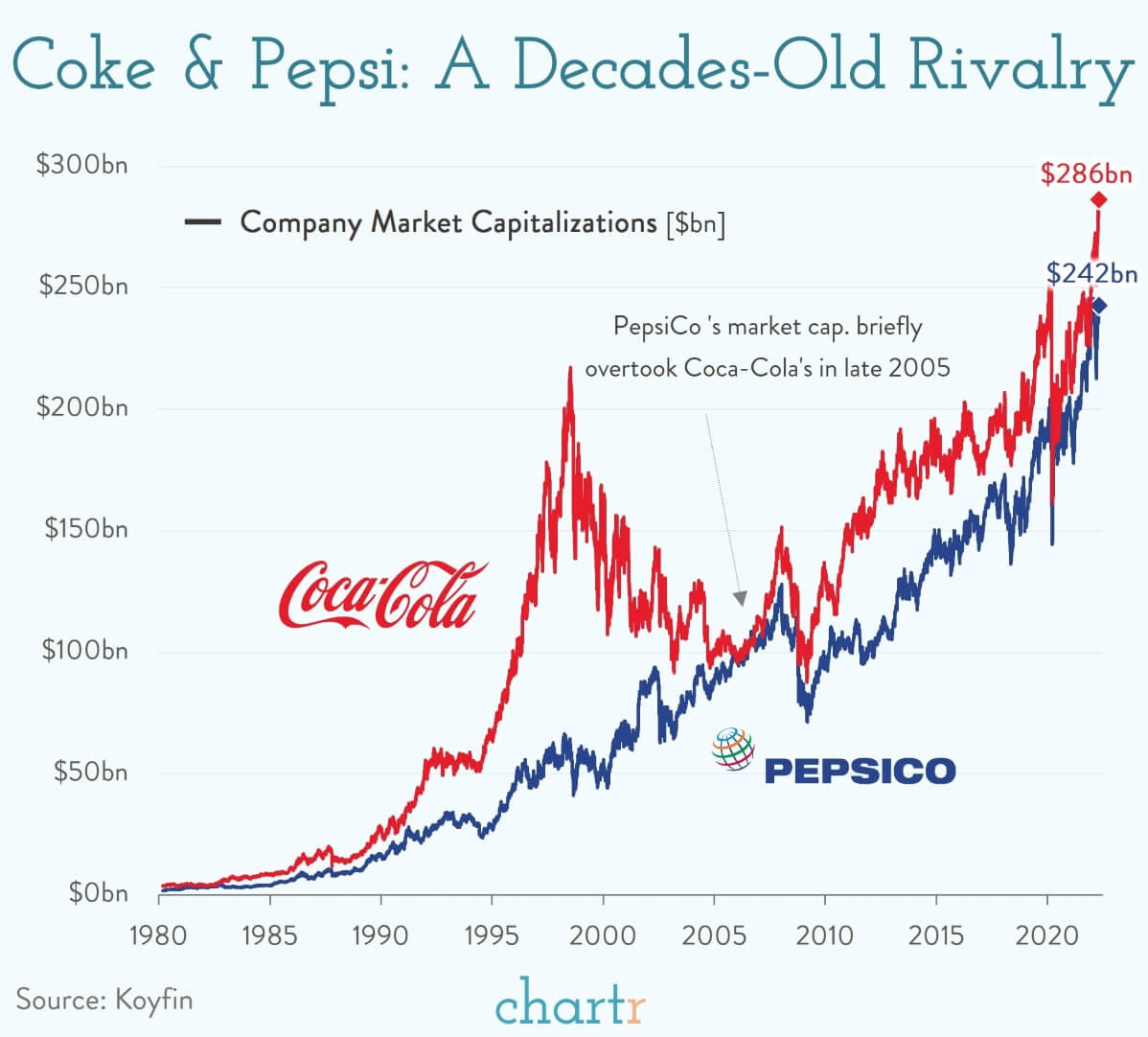
Leave a Reply